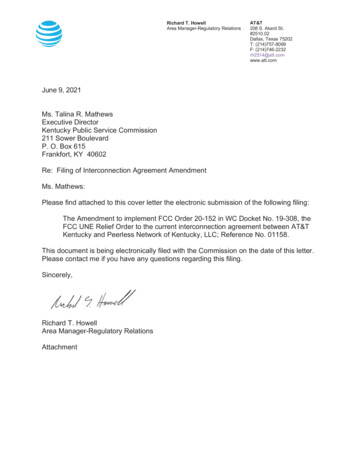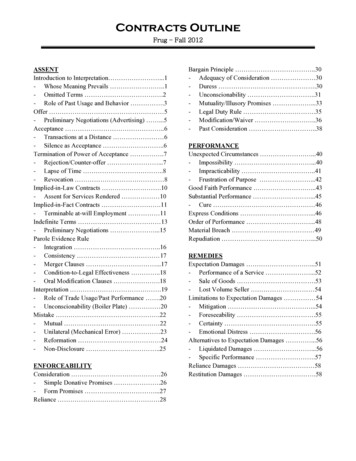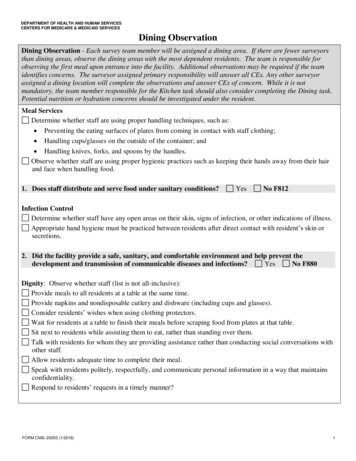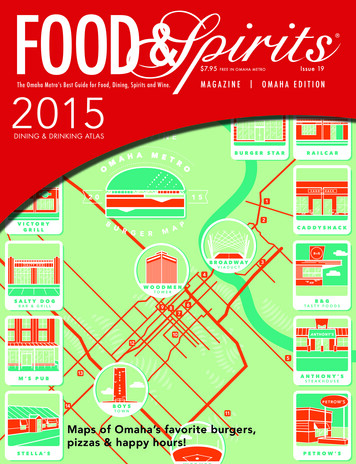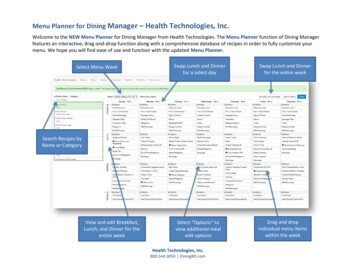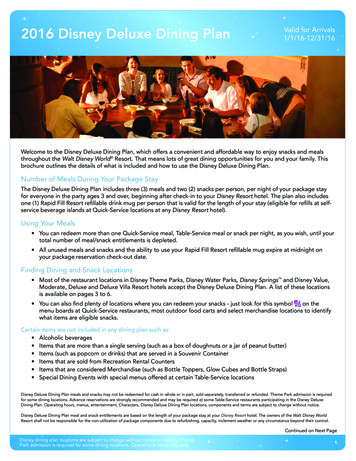
Transcription
News and Views to Strengthen Your Healthcare Foodservice Operation Summer 2014Peerless in Lapeer: A DiningRoom TransformationThe Thrill of the GrillCost, Care, and Customer ServiceWhat Kind of Leader are You?Gordon Food Service
Welcome toNews and Views to StrengthenYour Foodservice Operation A quarterly publication of Gordon Food Service Issue 14 · Summer 2014EditorAndy MaierManaging EditorDanielle BloomConsulting editorRobin WatsonAdvertisingDanielle BloomEditorial DirectorDana Fillmore, RD, CP-FSEditorial AdvisorsDana Fillmore, RD, CP-FSSara Kwiatkowski, RDGerry Ludwig, CECRecipe DevelopmentEd Westerlund, CECRecipe NutritionJessie Waalkes, RDResearch AnalystAshley MoritzPhotographyJulie Line, Big Event StudiosRobert Neumann, Big Event StudiosFood/Prop StylistMichelle Callaghan-HaleAccount ManagerMelissa AyotteDesignerJulie BaldwinEnrich Welcome to the Summer edition of Enrich! This issue offers a ray of sunshineas we tackle many topics challenging the healthcare industry today.The Triple Aim of the Patient Protection and Affordable Care Act prioritizesimprovements in cost, care, and customer service. Consultant and publicpolicy expert Nick Manetto offers his assessment of the progress made afterthe first four years of the healthcare law and the challenges that loom ahead.Don’t miss this article on page 18, filled with updates and thought-provokinginsights to help you achieve your cost, care, and customer service goals.Speaking of improving costs, take time to review the Cutting Costs ThroughBenchmarking article. Hear from operators who have been successful inmanaging their costs and improving their operation by benchmarking withthe AHF Benchmarking Express program. Your Gordon Food Service CustomerDevelopment Specialists are eager to help you enjoy similar success and getyou started with your own benchmarking. Ask them how.A great example of how food and nutrition services can help healthcareoperations meet care and quality goals comes from Lapeer CountyMedical Care Facility in Michigan. Chef Allen Alvarado and his team sharetheir approach to improving the dining experience and, ultimately, theentire organization. You’ll be both impressed and inspired by what this teamhas accomplished. Read on for additional ideas such as the importance ofgood service from your waitstaff, and increasing meal and snack choices foryour customers.Our culinary focus spotlights the opportunity to use outdoor grilling to createexcitement around your foodservice program. Check out the delicious andrefreshing recipes, but be warned, your mouth may just start watering.Production ManagerDeb DanielsPublished for Nursing Home and Hospital FoodserviceDirectors as well as Senior Meal Program Operators, thispublication provides timely information about food andservice trends, industry information, regulatory andlegislative updates, recipes, and new products. It is our goalthat customers know Gordon Food Service understandstheir industry, their needs, and that we have the tools,resources, and solutions to help them be effective andefficient operators.49728/6MThe opinions, beliefs, and viewpoints expressed by thecontributors to Enrich magazine do not necessarily reflectthe opinions, beliefs, viewpoints, or official policies ofEnrich magazine or of Gordon Food Service Inc. Enrichmagazine and Gordon Food Service Inc. do not guaranteethe accuracy of all published works. All works submitted toEnrich magazine for publication become the expressproperty of Gordon Food Service Inc. No reproduction ofthe contents of Enrich magazine, in whole or in part, maybe made without the express written consent of GordonFood Service Inc. Copyright 2014, Gordon Food Service Inc.All Rights Reserved. Enrich, GFS, and Gordon Food Serviceare trademarks of Gordon Food Service Inc. Othercompany, product, and service names may be thetrademarks or service marks of others.DANA FILLMORE, RD, CP-FS, Editorial Director. Dana Fillmore manages HealthcareMarketing for Gordon Food Service. Previously Dana was the Manager of NutritionServices for Gordon Food Service, providing expertise in matters related to nutritionand food safety for all Gordon Food Service customers. Her professional membership inthe Academy of Nutrition and Dietetics and her background as Adult Foster CareConsulting Dietitian and Clinical/Foodservice Dietitian supports her specialty innutrition and foodservice. Her professional food safety certification is supported by theNational Environmental Health Association.
18features6Cutting Costs throughBenchmarkingDiscover how dataanalysis and comparisonsstrengthen operations.1214The Thrill of the GrillAdd variety to the menuand excitement toresidents’ routines.Peerless in LapeerA dining program’stransformation makes adifference in Michigan.18 Cost, Care, and CustomerService: The Triple AimA look at the progressin administering theAffordable Care Act.2224columns10 e nhance Increasing access to food offersenhanced choices and canimprove clinical outcomes.22 Manager’s Memo Train for superior service thatmakes residents feel welcomeand special at mealtime.32 industry Update33 ASK THE DIETITIANin the kitchen24 Grilled Romaine Salad25 Garden Grilled Vegetables27 Grilled Island Salmon28 Tea-Brined Grilled Pork Loin30 Italian Pesto Sliders31 Herb-Grilled Chicken Understanding gluten labelsand nutrition recommendationsfor pressure-ulcer management.34 engage Assessing your leadershipstyle helps manage staffand situations.In Every Enrich 234Welcome to EnrichAdvertiser indexOn the Cover:Initiating culture change, and enhancing theoverall foodservice experience in Lapeer,Michigan. Page 14ENRICH Summer 20143
SAME HEINZ QUALITY,NOW WITHLOWER SODIUMAt Heinz, making smart choices doesn’t have to mean losing flavor. We proudly offer a large portfolio ofcondiments, sauces, soups, entrees and tomato products. Additionally, we offer lower sodium ketchup andsoups, as well as fat free condiments and salad dressings. These options can help meet your patient feeding andcafeteria needs while offering the great taste your patients and customers have come to expect from Heinz.To learn more about the full portfolio of Heinz products and brands,or to access downloadable rebates, visit www.heinzfoodservice.com.Smart Ladle Tomato SoupReorder No. 599580 Sodium: 400mg/servingLow Sodium Ketchup (9g)Reorder No. 603842 Sodium: 25mgSee page 34 for more information.Smart Ladle Cream of Mushroom SoupReorder No. 599562 Sodium: 410mg/serving
See page 34 for more information.
Cutting Costs ThroughBenchmarkingby: Aaron FrazierReducing the cost of healthcare, improvinghealth, and enhancing the patient experienceare primary goals of the Patient Protection andAffordable Care Act. To meet these goals, every facet ofthe healthcare industry is dealing with cost-containmentpressures. Food and nutrition departmentsare no exception.Benchmarking measurements let yousee exactly where your costs areout of line with the norm.One of the most valuable tools for identifying costcutting strategies is benchmarking, a standard or referenceby which existing procedures can be measured or judged.6Gordon Food ServiceBusinesses began embracing benchmarking as standardoperating procedure in the mid- to late 1980s, using it toidentify their comparative strengths and weaknesses versussimilar processes. This knowledge helps guide processimprovements, including cost reduction and operationalefficiencies, and aids in differentiation marketing.The success of benchmarking in the commercial sectorcompelled many governmental and nonprofit organizationsto adopt benchmarking as early as the 1990s. That’s whenthe seeds of AHF Benchmarking EXPRESS, a service ofthe Association for Healthcare Foodservice, were planted.“One of our legacy organizations instituted abenchmarking program for healthcare operations way backthen,” says Julie Jones, Director of Nutrition services for alarge Midwestern academic medical center and a memberof AHF’s benchmarking committee. Acute-care hospitalshave blazed the trail in financial benchmarking over theyears, and now with the cost pressures of the affordablecare era, more and more hospitals and post-acute-carefacilities are joining the ranks of avid benchmarkers.
F E ATUR E: Cutting Costs Th ro u gh Benchma rk ingKey performance indicatorsRelaunched in August 2013, the new AHFBenchmarking EXPRESS provides access to 64 keyperformance indicators (KPIs) important to healthcarefood and nutrition directors. That said, “I don’t knowanybody who looks at all 64,” Jones says. “One of theadvantages of the system is that it is really customizableand lets users work with the KPIs that matter to them.”Most operators, Jones says, are interested in just a fewKPIs, usually these: Food cost per patient day. Total food cost (includingfloor stock, supplements, catering, etc.) divided bypatient days. Total cost per patient day. Total food costs plus supplycosts, other direct costs, labor except clinical, andlabor costs clinical only, divided by patient days. Net of cash per patient day. The sum of costs minusthe sum of all cash divided by patient days. Net cost per patient day. The sum of costs minus thesum of retail cash, catering cash, other cash, transfers/credits, and foregone revenue, divided by patient days. Labor hours per meal. Productive hours divided bytotal meals.Each AHF Benchmark EXPRESS user inputs data fromhis or her own department once a month. The systemaggregates the numbers to reveal a snapshot of the user’sindividual performance and how it stacks up against otheroperations in the system (roughly 175 at press time).The information is presented in terms of percentiles, sousers can see how they rate compared to the 25th, 50th,and 75th percentile of operations in the system. Users alsocan sort results to compare themselves to operations of likebed count, service type, and location.“Most numbers you want to be low—like net costper patient day,” says Liz Boone, Executive Director ofNutrition Services at an 800-bed Midwest hospital andchairwoman of AHF’s benchmarking committee. “Othersyou want high, like average cost per transaction. A lotof directors will set departmental goals based on thisinformation—say, ‘We want to be at or below the 25thpercentile for this KPI.’”ENRICH Summer 20147
F E ATUR E: Cutting Costs Th ro u gh Benchma rk ingIdentifying “out-of-line” costsSo exactly how does this help with cost cutting? Well,you can’t manage what you don’t measure, maintainsGordon Food Service Healthcare Marketing ManagerDana Fillmore, RD, CP-FS. Benchmarking measurementslet you see exactly where your costs are out of line withthe norm; the data you’ve collected about your operationprovide the means to analyze and improve your operationand bottom line.Consider net of cash per patient day, for example.“It’s my favorite metric because it’s the truestrepresentation of departmental performance,” Boone says.“If your number is too high, you need to do something toaddress it. You can’t control patient days, so you have tolook at costs and revenues.”On the cost side, make sure you’re taking full advantageof group purchasing organization contracts and rebates.Talk to your suppliers about switching to less expensiveproduct alternatives. Consider implementing systems thatcan cut down on food waste, spoilage, and excess inventory.Think about pushing reusable mugs in the employeecafeteria and charging for disposable containers. Perhapsit’s even time to look at cutting cafeteria hours or changingthe way you do catering.On the revenue side, work on bumping up your averageretail transaction by offering more craveable foods, raisingprice points, decreasing portion sizes, bundling food8Gordon Food Serviceproducts, and promoting impulse purchases. Considerdoing away with employee discounts and freebies. Woulda coffee kiosk or sandwich cart bring in more money thanyou’d outlay to maintain it? How about an unstaffedmicromart for employees?You can’t managewhat you don’t measure.Some of these changes will encounter resistance, butbenchmarking gives you the numbers to justify yourrecommendations to administration—and to employees,if need be.You can perform a similar analysis and exploration for anyother KPIs that are out of whack. On the other hand, youalso can use benchmarking to counter cost-cutting requests.Let’s say patient days have declined and you’re askedto reduce your full-time employees. But you use KPImetrics to show that patient meals have stayed a steady25 percent of your total meal mix, thanks to an increasein non-patient meals. And you can use the labor-hoursper-meal metric to prove that employee productivity hasremained constant.
F E ATUR E: Cutting Costs Th ro u gh Benchma rk ingTalking to administrationJones says the ability to talk to administrators in thelanguage they understand—numbers—is a key benefit ofbenchmarking.“You should be sharing your most important KPIswith administration on a regular basis,” Boone says. AHFBenchmarking EXPRESS presents a lot of information inan at-a-glance graphic format ideal for presentation.“Without benchmarking, you’re just not prepared to dealwith cost-cutting requests like these,” she emphasizes.“I’ve had directors tell me that their administration isn’tasking for this kind of information, so they don’t feel theneed to benchmark.”This is particularly helpful when you are new to afacility and trying to understand the operation, and whenyou’re orienting new leadership to your department andservices.But Jones predicts that it’s only a matter of time beforemost of these directors are confronted with a mandate to cutdepartmental costs—and they won’t be equipped to respond.“You can’t say, ‘Give me five months to gather myfigures and I’ll get back to you,’” Boone says. “You need theinformation at your fingertips all the time.”Besides, benchmarking allows you to “toot your ownhorn” with administration.“And,” she adds, “it’s a great tool for justifying newprogram proposals, setting department goals, andbudgeting.”It’s clear that cost reduction will be a major thrust ofhealthcare for the foreseeable future. Benchmarking willhelp you contribute to your organization’s cost-cuttinggoals while demonstrating the continued viability of yourdepartment, especially if you wish to remain self-operated.EFor More InformationContact your Gordon Food ServiceCustomer Development Specialistfor assistance with yourbenchmarking needs.ENRICH Summer 20149
CO LU M N : E N H A N C EEnhance .EnhanceSatisfactionBy Increasing Access to Foodby: William CollierResident-centric foodservice is acritical part of culture change inlong-term care.It goes hand in hand with theparadigm shift that’s giving residentsmore control over their environment,according to Diane Hall, RD, LD,NHA, president of the Florida-basedconsulting firm, Balance SeniorNutrition. Letting people decide forthemselves when and what they wantto eat improves clinical outcomes and,Hall maintains, respects their dignityand independence.“People who might not ordinarilyeat a sit-down meal may opt forsnacks throughout the day,” Hallsays. Hall is in the process of helpinga Florida-based senior-care providerimplement 24/7 “snack cafés” at eachof its locations.“One of the first things we had todo was get the buy-in of medicalstaff,” Hall says. “They had to agreeto ‘liberalized diets.’ As a result, we’veeliminated all restrictive diets exceptfor consistency diets.”Maintaining a 24-hour operationdoes increase costs, she admits, butshe stresses that the change mayalso mean a reduced need for costlymedical intervention as residentsbetter maintain weight and vitality.“You have to look at the long-term,”Hall says. One way to minimizecosts is to offer grab-and-go items inoff-hours rather than (or in additionto) made-to-order items. The 24/7route isn’t the only possible solution,either—offering baskets of fruit orsnacks such as cookies or popcorn10Gordon Food Servicethroughout the day can be veryeffective. Place them in activityrooms or communal kitchens, andthe aroma alone can uplift residents.Another affordable option is to installa mini-fridge stocked with freshfruit, beverages, puddings and yogurts,sandwiches, and other snack items.“Most facilities offer a version ofsnack carts,” Hall says. “These typicallyinclude graham crackers, cookies,and other foods that don’t work forconsistency diets. A refrigerator allowsyou to offer food everyone can enjoy.”People who might notordinarily eat a sit-downmeal may opt for snacksthroughout the day.Place refrigerators in neighborhoodkitchens or dining areas, or in view ofthe nurse’s station. “You want residentsto have free access, but you also wantto maintain some supervision.”Be sure to enforce normal foodsafety and sanitation standards.“Increasing food access requires amultidisciplinary approach to foodsafety,” Hall says.Provide food-safety training beyondjust the foodservice department.Educate residents’ families, too,because resident-centric foodservicealso encourages visitors to bring infood for their loved ones.Skilled-nursing centers aren’t theonly providers seeking to increasefood access. Nontraditional foodoutlets are springing up across thehealthcare spectrum. These operationsare satisfying customer demand whilegenerating new revenues in ways such as:Ancillary dining spaces. Traditionalcafeterias and dining rooms are beingsupplemented with restaurant-likeconcepts that offer longer hours,especially in the evening, and mayalso be marketed to the outside public.Satellite cafés in hospitals—near theER or ICU, for example—are enablingpeople to stay closer to familymembers, Hall says.Kiosks and carts. Coffee kiosksand grab-and-go carts in strategiclocations enable residents, employees,and visitors to satisfy cravings withouttrekking to central dining locations—an especially welcome benefit onlarge campuses.Retail outlets. Mini conveniencestores, stocked with a variety ofpackaged and ready-to-go-foods aswell as household sundries, are on theincrease. Unstaffed micromarts are alsobeing used to give second- and thirdshift hospital employees more foodchoices when cafeterias are closed.Whatever you do, make sure it’s agood fit for your facility. The first stepto increasing food access is to surveyyour customers. Their answers willguide your planning process.“It’s not about whether they like cheeseor spinach,” Hall explains. “It’s when andhow and why they like to eat.” E
547850547772547871GFS Barbecue Sauces feature six flavor profiles, including three new flavors–Gold Barbecue,Honey Barbecue, and Southern-Style Barbecue. These versatile sauces provide a homestyle tasteand are excellent as a marinade, a dipping sauce, or as a finishing touch on grilled sandwiches or salads.For more information, contact your Gordon Food Service Customer Development Specialist.See page 34 for more information.
TheThrillof the Grillby: Robin HillSummertime backyard barbecues are practically anational pastime for people in their prime. Andyou can make those occasions more than just fondmemories for long-term care and senior-living residents byadding grilling to your foodservice repertoire.Grilling is a delicious way to whet residents’ appetiteswhile creating a social occasion that engages them. Plus,grilling gives food and nutrition directors a chance tooffer variety and show off their creativity.There are many ways to configure your grilling service.For example, one Midwest nursing home instituted amonthly grilling day. A large outdoor grill was set upjust outside the cafeteria. Windows were opened so thearoma of grilled summertime favorites, like burgers,hot dogs, and brats, could be smelled throughout thebuilding.“It created extra excitement for residents,” saysGordon Food Service Nutrition Resources ManagerSara Kwiatkowski, RD. “There was so much anticipation.They could smell the food grilling. It was somethingdifferent, a special-occasion day. It broke up themonotony, even though the regular menus therewere extensive.”Grilling is a delicious way to whetresidents’ appetites while creating asocial occasion that engages them.Getting startedA number of practical considerations come into play,everything from determining what you can do to howyou can do it.Gear up. Purchase or lease any necessary equipment.Assess staff needs. “It’s an extra effort to get out of thekitchen and cook the food, so ask yourself if you can doit even if you bring in extra help,” Kwiatkowski advises.Run the numbers. Consider how grilling will affectyour inventory needs and food budget.Schedule it. Decide how often you’ll offer grilling.Monthly, weekly, or more often? Also decide whether tolimit it to just summer or other seasons. One excellentoption for keeping the scale manageable, Kwiatkowskisays, is to serve small segments of the resident populationat a time on a rotating basis, such as a certain wing on adesignated day.12Gordon Food Service
feat ure: The Th rill o f the GrillPlan and post menus. Planning ahead helps controlfood and labor costs. Posting the menu in advance buildsanticipation among residents. Take care to vary the menu;don’t offer the same grilling specials every time.Gather input. “Get opinions at a resident councilmeeting and gain their buy-in,” Kwiatkowski suggests.The residents will be vocal, so you’ll know right away ifthey like it.Be accommodating. Residents with special dietary needs,such as low-sodium or low-cholesterol diets, need to followmedical orders, so always offer options, Kwiatkowskirecommends. If you’re grilling burgers, offer a turkeyburger or grilled chicken breast as an alternate selection.Be advised, she adds, that “a little extra planning may beneeded depending on how many grills you have.”Build excitement. Promote grilling day as you would anyevent. If possible, open windows so the aroma of grilledfood can entice patients.Do lunch. “The elderly eat better at the noon hour,”Kwiatkowski says. “Lunch is often their biggest meal ofthe day.”What to menuOnce you decide to offer grilling, there’s a world ofpossibilities for what to serve, as long as you observe a fewsimple food-safety rules.Burgers. “You don’t want to deal with raw groundmeat,” says Gordon Food Service Corporate ConsultingChef Gerry Ludwig, CEC. “Use high-quality, frozen, rawground beef or turkey patties that can go right on the grilland cook up beautifully. They thaw as they cook and turnout just as juicy as fresh.”Boneless, skinless chicken breasts. “This is a desirablemenu item even though it is a volatile choice from a foodsafety perspective. Use herb and spice rubs—many aresodium-free—or simple marinades such as a little oil withsoy sauce, fresh lemon, or lime juice to kick up flavor,"Ludwig advises. Grilled chicken breast can serve as a saladtopper, sandwich protein, or primary entrée.Grilled vegetables. “With diverse choices and a highlevel of food safety, grilled vegetables are a natural choice,”Ludwig says. Cut cauliflower into “steaks”’ and marinatethem in olive oil and lemon juice before grilling. Use largercuts of zucchini or yellow squash. Include asparagus if yourbudget allows, and take the opportunity to highlight somein-season local vegetables.Kebabs. Skewer chicken, beef, or pork with vegetables.If you’re using raw, whole-muscle meat, make sure it’s fullycooked before serving.Pork ribs, back ribs, rib tips. “Ribs are highly appealing,”Ludwig notes. “You can get them nice and crispy,caramelized, and smoky with a high level of food safety.”Hot Dogs and Sausage. Precooked hot dogs andsausage cook quickly, increase food safety, and aresummertime staples.Seafood. While seafood can be a pricey addition to yourmenu, the right portion purchased at the right price canelevate your menu without breaking the bank. Ludwigsuggests salmon, noting, “Salmon steaks hold up wellon the grill and can be seasoned many different ways.”See page 26 for a recipe.Whole-muscle cuts of meat. “The one with the highestlevel of food safety would be some sort of beef steak,”Ludwig says, “though there are cost constraints, and youmust make sure they’re tender enough to eat. The numberone cut for this scenario would be chuck tender cut acrossthe grain; it’s very tender and easy to eat. For wholemuscle pork, opt for boneless pork tenderloin. Cut it intomedallions that you can put between plastic and pound tocreate thin cutlets for grilling quickly on a hot grill or usingin kebabs. Grilled pork chops are also nice.” EFood-Safety ConsiderationsOutdoor grilling requires all the usual practices,plus extra vigilance to keep residents safe.Prevent cross-contamination. Keep preparationsurfaces clean. Change or clean cutting boardswhenever you switch between proteins and/orvegetables. Use separate utensils and platters for eachitem; never switch between raw and cooked foods.Bring out uncooked food in increments. “Make sureyou have enough staff to keep bringing out refills ofraw food to be cooked unless you have a number ofgrills going at the same time,” Kwiatkowski advises.Serve food immediately. “As always, do not leavefood sitting out for a long time,” Kwiatkowski says,noting that it’s important to keep hot food hot andcold food cold.Maintain proper temperature control. Cold food must be held at 41ºF, or below. Poultry products must be cooked to 165ºF andheld at 135ºF or higher. Beef patties must be cooked to 155ºF and heldat 135ºF or higher. Fish must be cooked to 145ºF and held at 135ºF.ENRICH Summer 201413
Peerlessin Lapeerby: Patrick BaxHearing that one of your cooks made a resident burstinto tears is not the way you want to greet the morning.But Allen Alvarado, Executive Chef of Lapeer CountyMedical Care Facility, was pleasantly surprised when herushed over to console the resident in question.“She said to me, ‘I just want you to know that I’ve beenhere for many years, and this is the first time I’ve orderedan over-easy egg and gotten an over-easy egg, just the wayI like it,’” Alvarado recalls. “She was crying tears of joy.”That resident’s experience—and others like it—confirmsfor Alvarado, his staff, and facility administration that theiroverhaul of the food and nutrition programs these past fewyears has been well worth it.Lapeer County Medical Care Facility is a 202-bedskilled-nursing center in eastern Michigan, on a site thatwas originally set up as “The County Poor Farm” in thelate 1800s. A skilled-nursing facility was built on thegrounds in 1971. In 2011, the facility embraced culturechange and began making its environment more home-likefor residents.Dining was a key consideration in this transition, andadministrators wanted a high-caliber chef to guide theprocess. Enter Alvarado, who had moved back to the areaafter an illustrious career with such foodservice titans asOrlando’s Church Street Station, Nashville’s Wild HorseSaloon at the Opryland Hotel, the Florida-based, upscale14Gordon Food ServicePuff ’n Stuff Catering, and Emeritus Corporation, whichoperates nearly 500 senior-living communities in 47 states.Upon returning to his hometown of Lapeer, Alvaradohung up his apron and was pursuing another line of work.But, when his daughter saw an ad that read, “Looking for achef with heart,” she sent in her father’s resume.Lapeer County Medical Care Facility called him the nextday. And it wasn’t long before he was helping to overseeservice of 900 to 1,200 meals a day while managing acomplicated kitchen and dining transformation.Welcome to the neighborhood“The facility was originally built with a commissarykitchen, where food was prepared and plated for transportto the dining room, where it was served via tray line,”Alvarado explains.As part of the culture-change initiative, Lapeer built anew addition and established six “neighborhood zones,”each with its own private dining rooms and kitchens.“We were going to tackle them one a time, but we finallydecided to do them all at once,” he says. “That was a bit of achallenge.”Indeed it was, concurs Culinary Supervisor KathleenMorris, who retired in April after more than two decadeswith Lapeer.
feat u re : P ee rless in L apee r“We worked out of a school kitchen for five weeks orso—it was during the summer—and transported mealsback to the facility via Cambro carriers,” she recalls.During the transition, the staff also visited other nursingfacilities to get a firsthand look at the restaurant-styleservice Lapeer would be implementing.“Change is hard,” Morris acknowledges. “And we werechanging almost everything—menus and recipes, the waywe ordered, how we served meals, and our interactionswith residents.”More than once, Morris and Alvarado heard objections,such as, “But this is the way we’ve always done it.” Theycountered by positioning the changes as opportunitiesto grow and learn new, more marketable skills. Theyinstituted ongoing training programs covering everythingfrom ServSafe skills to proper service manners. But whatreally made the difference was the way residents reacted tothe changes.“When you get compliments on the food and the wayyou’re handling yourself, you feel good about what you’redoing,” Alvarado says. “And the neighborhood conceptenables us to build much closer relationships withresidents, which has been very rewarding for all of us.”That’s how a cook learns to prepare an over-easy egg “theway my mom used to do it” or leave the greens off a chickensandwich “because I don’t like lettuce.” Similarly, serverscome to anticipate residents’ preferences, such as whetherthey like coffee before or after their morning toast.“I tell everybody to approach their job like they’recooking for and serving family,” Alvarado says.Focus on real foodOf course, sometimes family members need a littleextra help.“Malnutrition and dehydration are the biggest challengesfor dietary staff,” Alvarado says. “I meet with our registereddietitian regularly, and with our nutritionist almost daily,to monitor resident nutrition needs. We’ve made a realeffort to address these cha
Consulting Dietitian and Clinical/Foodservice Dietitian supports her specialty in nutrition and foodservice. Her professional food safety certification is supported by the National Environmental Health Association. News and Views to Strengthen Your Foodservice Operation A quarterly publication of Gordon Food Service ISSuE 14 · SuMMEr 2014
